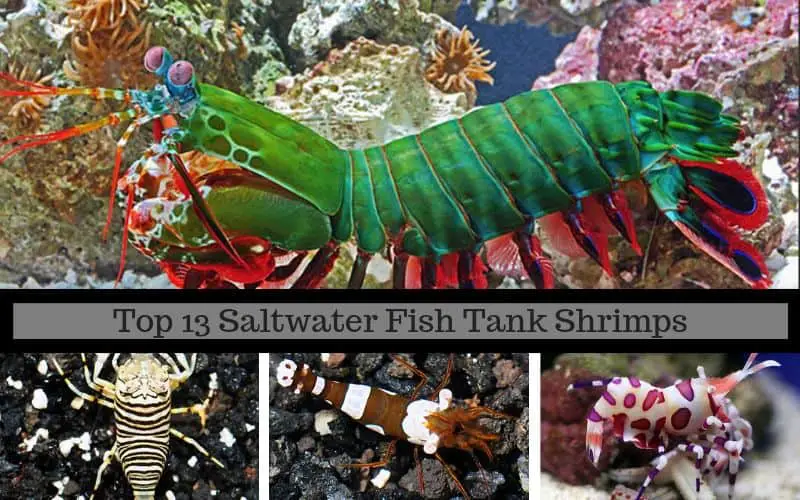Are you thinking of buying a Saltwater-Reef Fish Tank and are looking to add something a little different?
Then this article TOP 13 Saltwater Fish Tank Shrimps might be just what you’re looking for. In this article, we look at the most popular Saltwater shrimps kept in the home aquarium. They all have something different to offer and add an extra dimension to your aquarium.
Shrimps offer a variety of behavioral characteristics and make interesting inhabitants to any saltwater or reef aquarium. Some shrimps offer a free cleaning service to your fish eating unwanted parasites an added bonus. Then there’s the venus Anemone Shrimp that live in and around anemones and not forgetting the amazing Pistol Shrimp that live side by side with Gobies and even share their homes.
Whatever your reason for checking out Saltwater shrimps you won’t be disappointed with any one of these amazing shrimps in your aquarium.
There are loads of shrimps that could have made it into our Top 13 Saltwater Fish Tank Shrimps list but we choose these on their popularity and quantity sold through the aquatic trade over the past few years. Everyone will have their own opinion on which ones are best but we thought the best indicator of popularity was numbers sold in the past few years.
This list is in no particular order and with no favoritism from us ( Although I love #9 it’s amazing )
Our Top 13 Saltwater Fish Tank Shrimps are :
- Peppermint Shrimp
- Pederson Cleaner Shrimp
- Scarlet Skunk Shrimp
- Sexy Anemone Shrimp
- Bumble Bee Shrimp
- Blood Red Fire Shrimp
- Banded Coral Shrimp
- Venus Anemone Shrimp
- Camel Shrimp
- Pistol Shrimp
- Mantis Shrimp
- Harlequin Shrimp
- Marbled Shrimp
Table of Contents
#1 Peppermint Shrimp (Lysmata Wurdemanni)
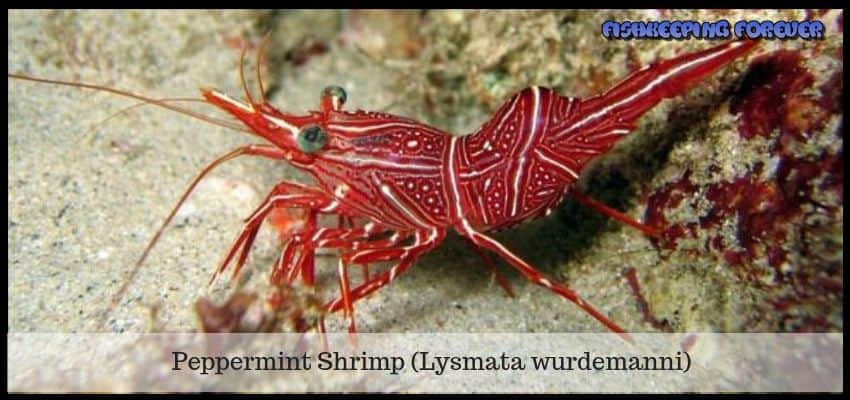
| Scientific Name | Lysmata wurdemanni complex |
|---|---|
| Family | Hippolytidae |
| Temperament | Peaceful |
| Care Level | Easy |
| Diet | Carnivore |
| Reef Safe | Yes |
| Max Size | 2.5" |
| Color | Red |
| Price | $10 |
The shy and nocturnal Peppermint Shrimp (lysmata wurdemanni) is an easily cared for reef compatible scavenger that will bring a dash of color to any saltwater aquarium. They are peaceful making them an excellent candidate to keep in larger groups.
Also known as the veined shrimp, candy cane shrimp or Caribbean cleaner shrimp the Peppermint Shrimp has a transparent body with red stripes all over. Hence the name peppermint or candy cane. They can grow up to around 4 cm/1.5 ins.
You will need to be wary of placing these little guys in with anemones as they have a taste for them. This, however, does vary from Peppermint Shrimp to Peppermint Shrimp. Keeping them well fed with sinking shrimp pellet and small pieces of fish from time to time should ease up their anemone snacking.
When adding the Peppermint Shrimp to your saltwater aquarium you will need to use the drip acclimatization method as they are very sensitive to changing water parameters. You should also know that they do not tolerate high nitrates or copper-based medications being used in their water.
You should also avoid putting Peppermint Shrimp in with large and aggressive tank mates as they will quickly become a snack. You may not notice this has happened at first as this shrimp is a hider through the day that in general only come out under blue light in the evenings.
Breeding of Peppermint Shrimp in the home aquarium will happen easily and you may notice your females are filled with eggs on a regular basis. Raising the ensuing larvae, however, is no easy feat due to the difficulty in feeding such small entities and a high level of predation.
#2 Pederson Cleaner Shrimp (Ancylomenes Pedersoni)
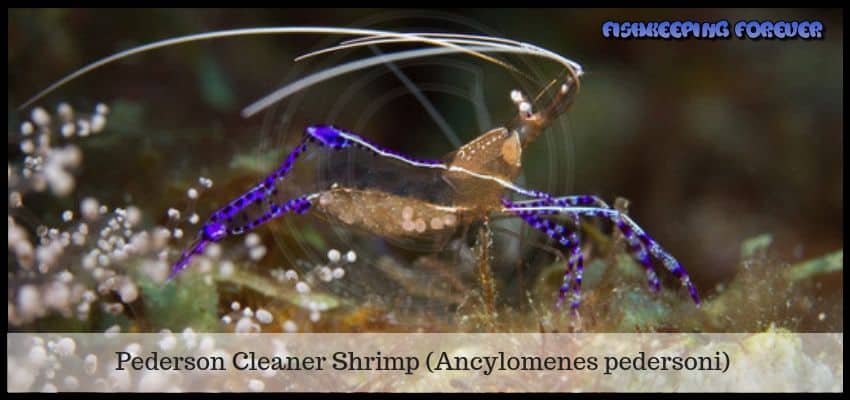
| Scientific Name | Ancylomenes pedersoni |
|---|---|
| Family | Palaemonidae |
| Care Level | Easy |
| Temperament | Peaceful |
| Diet | Omnivore |
| Size | 1.5" |
| Color | Clear, White, Blue |
| Reef Safe | Yes |
| Origin | Caribean |
| Price | $30 |
This omnivorous reef compatible shrimp is found naturally in the waters of the Caribbean and the West part of the tropical Atlantic. They live amongst live rock where they hide and forage forming relationships with anemone, in particular, the Bartholomea Annulata.
Although the relationship with anemone is not vital for the Pederson Cleaner Shrimps (ancylomenes perdersoni) health and wellbeing it does provide them with the means to perform their favorite activity; cleaning! Scientific research has shown that fish will seek out the Bartholomea Annulata knowing Pederson Cleaner Shrimp are waiting there to clean them. Once this shrimp spots a potential fish in need of cleaning, it waves its antennae around to attract attention.
Pederson Cleaner Shrimp grow up to around 1.5 inches and have a brown body with purple and blue markings. Their front claws are of a large size and also have a purple and blue coloration. They are easy to care for and will need feeding, as omnivores, a fish or meat-based diet.
At 1.5 inches the Pederson Cleaner Shrimp is not a huge target for other fish but care should be taken with larger predatory species. Also, ensure that they have plenty of places to hide during and after molting as they are extremely vulnerable at this time. Iodine can help with the growth and molting process as well as keeping pristine water.
#3 Scarlet Skunk Cleaner Shrimp (Lysmata Amboinensis)
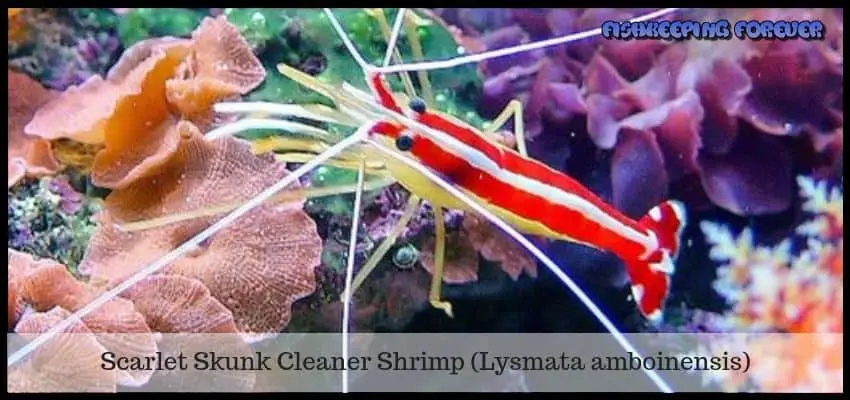
| Scientific Name | Lysmata amboinensis |
|---|---|
| Family | Hippolytidae |
| Origin | Africa, Indonesia, Sri Lanka |
| Temperament | Peaceful |
| Care Level | Easy |
| Reef Safe | Yes |
| Diet | Carnivore |
| Color | White, Red |
| Price | $30 |
Native to Africa, Indonesia, and Sri Lanka the Scarlet Skunk Cleaner Shrimp (lysmata amboinensis) lives in live rock and coral outcroppings where it waits for fish to swim along near it. It is not, however, laying in wait for a tasty snack but rather wishes to act as a kind of medic!
As fish arrive the Scarlet Skunk Cleaner Shrimp will climb aboard and rid them of ectoparasites and dead tissue. They do this all over the fishes body, in its gills and even in their mouths. No harm will come to either the shrimp or the fish, rather it seems to be a mutually beneficial exercise. The fish is rid of unwanted parasites and the cleaner shrimp is provided with some tasty scavenged food.
Also known as the striped cleaner, skunk cleaner and scarlet cleaner for its coloration the Scarlet Skunk Cleaner Shrimp has an amber to orange colored body. This is not where it gets its name from, however, that is down to the two scarlet stripes that run down its back either side of a white one.
Growing up to 2 inches in size the Scarlet Skunk Cleaner Shrimp is easy to care for, peaceful and reef compatible. Just be aware that fish species such as the hawkfish, lionfish and predatory crab or shrimp may see them as a snack. Like most other shrimp the Scarlet Skunk Cleaner is susceptible to fluctuating water parameters, high nitrates, and copper-based medications.
Also like most other shrimp, the Scarlet Skunk Cleaner Shrimp will molt its exoskeleton from time to time. Iodine supplements should be offered to saltwater shrimp to aid this and promote good growth. Be aware that during and after this molt any shrimp will be vulnerable until its new exoskeleton hardens. This is one of the most efficient cleaners you can add to any saltwater tank with only the Cleaner Wrasse being a more effective cleaner. We have a great article on Cleaner Wrasse Ultimate care guide a must read.
#4 Sexy Anemone Shrimp (Thor Amboinensis)
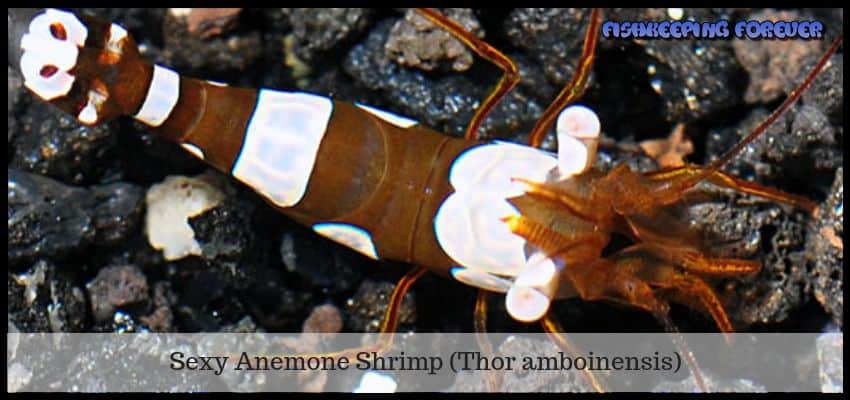
| Scientific Name | Thor amboinensis |
|---|---|
| Temperament | Peaceful |
| Care Level | Easy |
| Reef Safe | Yes |
| Origin | Indo-Pacific, Indonesia |
| Diet | Carnivore |
| Max Size | 1.5" |
| Color | Black, Red, Tan, White |
| Price | $12 |
This gorgeous and tiny, 2.8 cm/0.8 inches, shrimp are known as the Sexy Anemone Shrimp (thor amboinensis) has been named so because of the way they sway and vibrate their abdomen when they are walking. They are also known for their resting stance which involves arching their abdomens and tails towards their head. In this position, they rather resemble a scorpion!
Native to tropical seas and the Indo-Pacific the Sexy Anemone Shrimp has an amber to orange colored body with white spots all over. They are often found in groups of 20 plus in amongst carpet anemone. Males can be differentiated from females by the fact they are smaller.
Being one of the tiniest shrimp species Sexy Anemone Shrimp often attach themselves to anemone by collecting mucus from them which in turn masks their presence there. This is believed to hide this tiny guy from predators such as damselfish, gobies, and wrasses. Other larger shrimp may also pose a threat to the Sexy Anemone Shrimp.
A carnivorous shrimp the Sexy Anemone will eat most meaty aquarium foods. They should, however, be target fed very close to their host anemone as they will not move more than a few centimeters from it at any time.
Aquarium wise Sexy Anemone Shrimp need excellent water quality to survive and thrive. Low nitrates and no copper-based medications are a must with an iodine supplement being recommended for molting and growth.
Be aware that clownfish will not share an anemone with this shrimp and that breeding of the Sexy Anemone Shrimp is virtually impossible. This is because the larvae is little more than 2mm in size making it incredibly hard to feed and protect from predation.
#5 Bumble Bee Shrimp (Gnathophyllum Americanum)
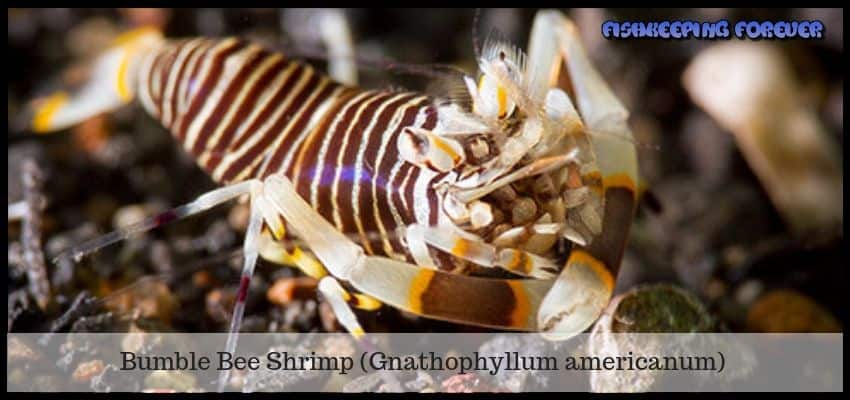
| Scientific Name | Gnathophyllum americanum |
|---|---|
| Family | Gnathophyllidae |
| Temperament | Peaceful |
| Care Level | Difficult |
| Size | 1" |
| Origin | Indo-Pacific |
| Diet | Carnivore |
| Reef Safe | Yes |
| Color | Orange, Tan, White, Yellow |
| Price | $10 |
Named for its resemblance to the bumblebee the Bumble Bee Shrimp (gnathophyllum americanum) is one of the smaller species reaching around just 1 inch in length. They do not, however, look anything like a bee, in fact, the only resemblance is shared coloration.
Also known as the striped harlequin the Bumble Bee Shrimp has a yellow, black-and-white striped body with some having orange markings on their legs. They are a shrimp that can only be described as stubby and plump but ridiculously cute!
Making a great addition to any reef aquarium the Bumble Bee Shrimp is a popular choice with aquarists but some care needs to be taken when keeping them. Being on the small side they can make a tasty snack for larger predatory fish and they, in turn, will snack on the tube feet of echinoderms (starfish).
Best kept in pairs in saltwater aquariums with moderate lighting the Bumble Bee Shrimp will need food offering to them on a daily basis. Frozen meaty foods such as brine shrimp, mysis shrimp, cockle and small pieces of fish are all suitable.
amzn_assoc_placement = “adunit0”;
amzn_assoc_search_bar = “true”;
amzn_assoc_tracking_id = “fishkeepers-20”;
amzn_assoc_ad_mode = “manual”;
amzn_assoc_ad_type = “smart”;
amzn_assoc_marketplace = “amazon”;
amzn_assoc_region = “US”;
amzn_assoc_title = “My Amazon Picks”;
amzn_assoc_linkid = “410f3bb0cb72871dd867d98b03a8065b”;
amzn_assoc_asins = “B06WP9Q6CZ,B01M2WI6PT,B003XMDJZ0,B01N53XPQ8”;
#6 Blood Red Fire Shrimp (Lysmata Debelius)
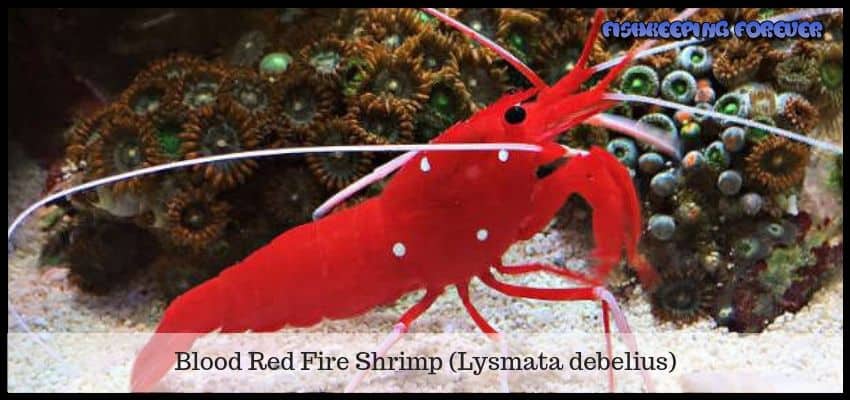
| Scientific Name | Lysmata debelius |
|---|---|
| Family | Hippolytidae |
| Temperament | Peaceful |
| Care Level | Easy |
| Origin | Indonesia, Sri Lanka |
| Diet | Carnivore |
| Max Size | 2" |
| Color | Red, White |
| Price | $35 |
The Blood Red Fire Shrimp (lysmata debelius) is a species of shrimp sure to give any saltwater aquarium a boost of dazzling color. In fact, it is this very burst of color that gives them the common nicknames of blood shrimp, fire shrimp, and scarlet cleaner.
With a bright red or scarlet body and several white spots and antennae, the Blood Red Fire Shrimp can reach up to 2 inches in size. The region of the Indo-Pacific that they come from will dictate whether they have white dots on just their carapace or their entire body.
Described as peaceful the Blood Red Fire Shrimp will get along with most organisms unless they are in his territory. They are best kept with a single mate of their own kind as they do not tolerate more of their own species well. For breeding purposes, this is not a problem as the Blood Red Fire Shrimp is a hermaphrodite. Again, however, raising the larvae, as with most species of shrimp, is not easy.
Typically a scavenger that feeds off meaty bits on the bottom of the aquarium the Blood Red Fire Shrimp is another species that will clean dead tissue and parasites from other fish. You are unlikely to see this, however, as they are an incredibly shy shrimp that are often found hiding with just their antennae showing.
To enable you to see your Blood Red Fire Shrimp more frequently you can try strategic feeding to coax them out of hiding. Providing dimmer light on an evening may also help with this too. Be aware that the Blood Red Fire Shrimp is known to nibble on coral during the night so care should be taken when putting this shrimp and coral together.
#7 Banded Coral Shrimp (Stenopus Hispidius)
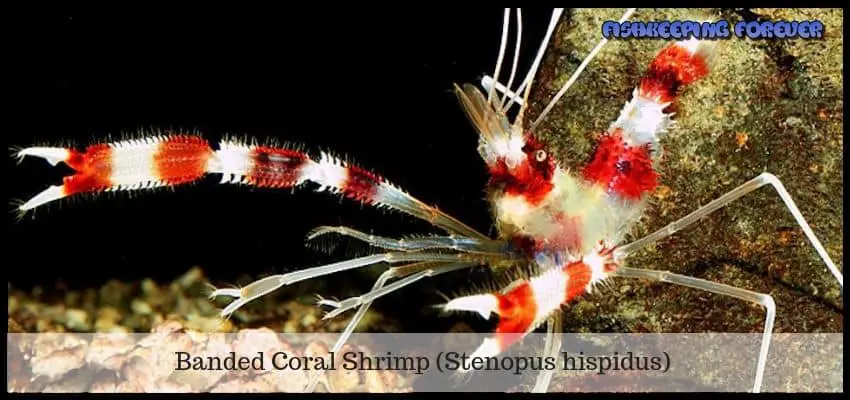
| Scientific Name | Stenopus hispidus |
|---|---|
| Family | Stenopodidae |
| Temperament | Semi-aggressive |
| Care Level | Easy |
| Origin | Caribbean, Cebu, Hawaii, Indonesia, Sri Lanka |
| Diet | Carnivore |
| Reef Safe | Yes |
| Size | 3" |
| Price | $15 |
Also commonly also known as the coral banded shrimp and the banded prawn, the Banded Coral Shrimp (stenopus hispidius) comes in a variety of different colors. These include red and white banded, golden coral, yellow-banded, blue banded and purple banded. They are an incredibly good looking species of shrimp.
Although all species vary in color they do share certain characteristics such as they all have bright red and white bands on their bodies and pincer claws. There is, however, one exception to this rule which is the S. Zanzibaricus which has just red bands. Both the first and the second legs of the Banded Coral Shrimp are equipped with pincers.
A nocturnal shrimp that is most often found in caves and under ledges the Banded Coral Shrimp is compatible with most fish but not each other. Banded Coral Shrimp are monogamous and somewhat territorial meaning they will fight with others of their own species that encroach on their territory. Often during these battles legs and pincers are lost! Luckily the Banded Coral Shrimp will grow these limbs back when they next molt.
Scavengers by nature Banded Coral Shrimp will eat most meaty foods and require a stable aquarium when it comes to water parameters. They are particularly susceptible to bad water chemistry and changes in pH. They are one of the larger shrimp species growing up to around 4 inches in size.
#8 Venus Anemone Shrimp (Anclyomenes Venustus)
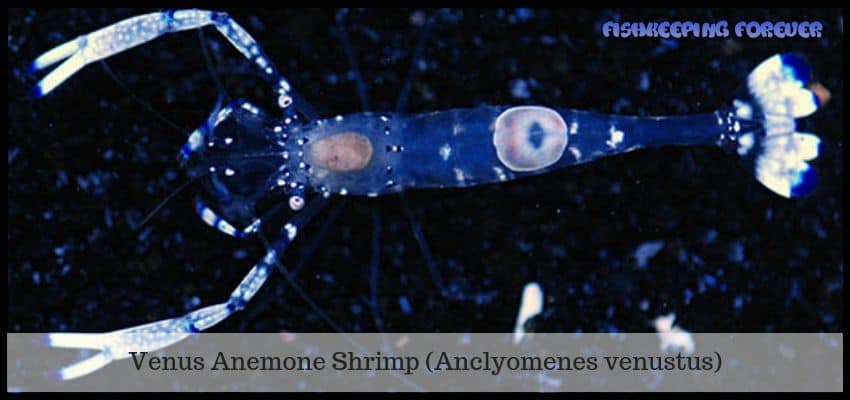
| Scientific Name | Anclyomenes venustus |
|---|---|
| Family | Palaemonidae |
| Temperament | Peaceful |
| Care Level | Easy |
| Origin | Indonesia |
| Diet | Omnivore |
| Reef Safe | Yes |
| Size | 1.5" |
| Price | $20 |
Found naturally in the waters of Indonesia, Papua New Guinea and Japan the Venus Anemone Shrimp (anclyomenes venustus) is an omnivorous easy to care for mid-size species of shrimp that is incredibly pleasing on the eye. They are also known as the glass shrimp which is a clue to their appearance.
Near transparency makes the Venus Anemone Shrimp virtually invisible to all around them and gives them a glass-like quality. They do, however, have some coloration starting with a white circular marking on their abdominal hump and additional purple to blue-hued speckles and bands on their claw arms and legs.
In their natural habitat, Venus Anemone Shrimp can be found living amongst hard coral and sea anemones. In fact, they often partner with stinging anemones to avoid predators. Venus Anemone Shrimp is a popular snack for larger predatory fish!
In the home aquarium, Venus Anemone Shrimp enjoy the nano-environment with lots of caves and nooks to hide in. As mentioned above avoid carnivorous tank mates if you don’t want your shrimp to go missing! Food wise, as with most shrimp, the Venus Anemone will scavenge but should also be offered freeze-dried, frozen and flaked options.
#9 Camel Shrimp (Rhynchocinetes Durbanensis)
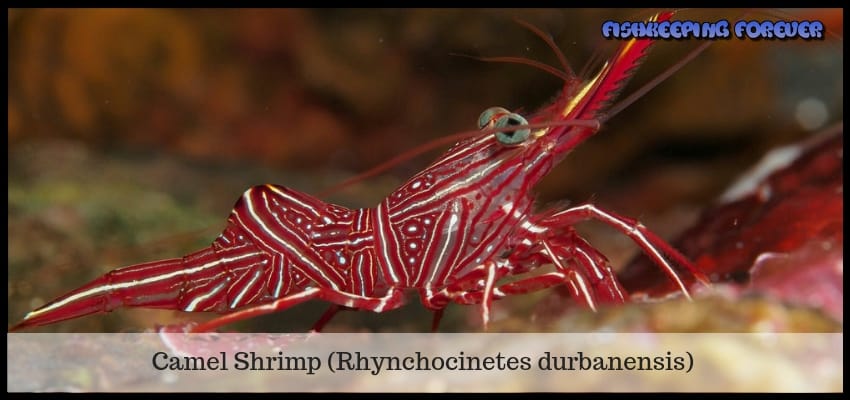
| Scientific Name | Rhynchocinetes durbanensis |
|---|---|
| Family | Rhynchocinetidae |
| Temperament | Peaceful |
| Care Level | Easy |
| Size | 2" |
| Diet | Omnivore |
| Color | Red |
| Price | $8 |
One of the larger species the Camel Shrimp (rhynchocinetes durbanensis) can grow up to approximately 2 inches in length in the home aquarium. They are also sold under the names of hinge-beak shrimp, dancing shrimp, and candy shrimp. All names were given to them for some characteristic this attractive species has.
As you would imagine the name Camel Shrimp comes from the distinctive hump that is on the back of this species, whilst hinge-beaked comes from the moveable rostrum (beak) that is usually angled upwards. Dancing shrimp, however, is a name that they have been given as food!
As unpalatable as we may find it or even repulsive the camel shrimp is served in places such as Thailand as a live food for humans, yes humans! This dish is found mainly amongst the stalls of street markets where the Camel Shrimp jump around in bowls. Hence the name dancing shrimp or Goong Ten in Thai!
Moving back to Camel Shrimp IN the aquarium this species is covered in a variable pattern of red and white markings all over its body. Males are distinguishable from females by the fact that they have bigger claws. They are best kept in large colonies of six plus due to their natural behavior of congregating together.
The ideal environment for your colony of Camel Shrimp is one that has lots of rock crevasses and overhangs for them to gather together in. Hiding places are especially important to this species of shrimp when they molt as they are incredibly vulnerable until their new exoskeleton hardens. When they have molted you should look out for mating behavior as this is the most likely time you will see it.
Although they are undoubtedly attractive and interesting to view the Camel Shrimp does have some care requirements that will need your attention. Camel Shrimp are renowned for nipping at colonial anemones, disc anemones, and soft leather corals. Whilst this does not sound much of a problem, believe me when I say it can be! Camel Shrimp can wreak havoc in aquariums decimating a healthy colony of star polyps in no time.
As with most shrimp, it is also not a good idea to keep Camel Shrimp with aggressive fish as they will become a target for them. Tangs and clownfish, however, make pretty good tank companions. Be aware that if you choose to keep a Camel Shrimp only aquarium that they are nocturnal and you may not see much action through the day.
#10 Pistol Shrimp (Alpheidae Sp)
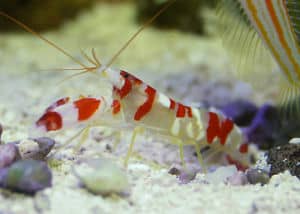
| Scientific Name | Alpheus randalli |
|---|---|
| Temperament | Peaceful |
| Care Level | Easy |
| Origin | Indo-Pacific |
| Diet | Carnivore |
| Family | Alpheidae |
| Size | 2" |
| Color | Red |
| Price | $25 |
At number nine is the Pistol Shrimp (alpheidae sp), a small anthropoid of 1-2 inches in size. What is lacks in size, however, it certainly makes up for in power. The pistol shrimp has its very own built-in stun gun!
This ‘stun gun’ comes in the shape of a spectacularly large claw that can be on either side of the Pistol Shrimps body. However, unlike most shrimp claws it does not have typical pincers. Rather it has what could be seen as pistol like pincers which are made up of two parts. The first is a joint that allows the hammer like part of the claw to move back into a right-angled position. The second part is that when released the pincer snaps back onto the other part of the claw.
Originally it was believed that the snapping sound this shrimp is known for came from the two pincers cracking together. This is not the case, however, as a team of scientists found out in 2000 when they were studying the Pistol Shrimp. In fact, the snapping sound is made by the bubbles that are created when the pincer lands in the socket and water bubbles out.
Known as cavitation the bubbles move away from the claw and explode creating the loud snapping sound and also emitting high heat, up to 18’000℉ in fact. A mix of this heat, sound, and movement serves to stun fish larger than the Pistol Shrimp and has even been known to break glass jars!
Perhaps surprisingly, the Pistol Shrimp still feels the need for protection from predators and teams up with the Goby fish to get it. The Pistol Shrimp digs out a burrow which both he and the Goby fish share, a hideout from those seeking to eat them. It doesn’t end there, however!
As the Pistol Shrimp is nearly blind just clambering out of its burrow and wandering around could be very dangerous. So instead it sends the Goby fish out first to act as its lookout. Placing its antennae onto the Goby fish when it ventures out it can then sense the threat of danger by the Goby’s movements. Should the Goby start to move quickly the Pistol Shrimp knows there is a danger and can retreat. If you like to read more on this amazing relationship then you have to read our article on the Top 15 Nano Reef Tank Fish list where we go into detail on the Yellow Watchman Goby and their relationship with shrimps.
#11 Mantis Shrimp (Odontodactylus Scyllarus)
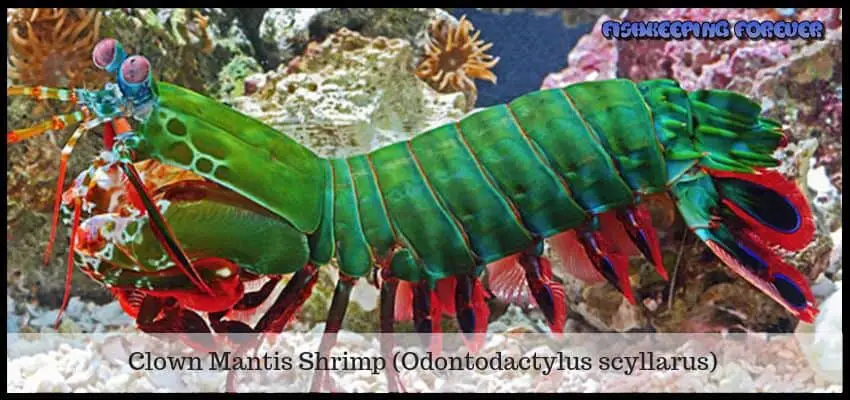
| Scientific Name | Odontodactylus scyllarus |
|---|---|
| Family | Gonodactylidae |
| Temperament | Aggressive |
| Care Level | Easy |
| Origin | Indo-Pacific |
| Diet | Carnivore |
| Size | 6" |
| Color | Red, Green, Blue |
| Price | $50-$60 |
It needs to be said straight away that the Mantis Shrimp (Odontodactylus Scyllarus) is 100%, definitely and absolutely not a community aquarium suitable shrimp in any way, shape or form. They are, however, a fabulous, feisty, beautiful and complex species that you will not regret keeping alone!
With over 500 species ranging from just 1 inch to around a foot in length, the Mantis Shrimp has spring loaded clubs and the ability to superheat the water around to them to temperatures nearly as hot as the sun! They will use these powerful weapons to fight anything such as each other, octopuses and even humans.
Whilst all Mantis Shrimp share a ferocious streak and awesome weapons, the modus operandi is not the same for all. Some Mantis Shrimp have what are commonly called ‘smashers’ which they use to knock their prey unconscious and others have spears which they use to impale!
The ‘spearers’ of the Mantis species can unleash their power and spear prey in just 20 – 30 millisecond. If you think that’s quick, it’s nothing compared to the smashers who knock their prey out 10 times as fast. But how do they do it?
The secret of the Mantis Shrimp’s fast and brutal actions is kept within their arms which have a spring-like quality which they can load by using a very forceful but slowly contracting muscle. When ready to spear or smash they simply release a latch and let the power unleash. This launches the same reaction as the Pistol Shrimp uses; cavitation.
Unlike Pistol Shrimp, however, the Mantis Shrimp has immense power in both arms and not a friendly bone in their body metaphorically speaking. You would not catch the Mantis Shrimp sharing a burrow with a Goby! What you might see, however, if you’re lucky is the Mantis blasting off or amputating a hunter crabs claws to immobilize them before killing.
amzn_assoc_placement = “adunit0”;
amzn_assoc_search_bar = “true”;
amzn_assoc_tracking_id = “fishkeepers-20”;
amzn_assoc_ad_mode = “manual”;
amzn_assoc_ad_type = “smart”;
amzn_assoc_marketplace = “amazon”;
amzn_assoc_region = “US”;
amzn_assoc_title = “My Amazon Picks”;
amzn_assoc_linkid = “410f3bb0cb72871dd867d98b03a8065b”;
amzn_assoc_asins = “B06WP9Q6CZ,B01M2WI6PT,B003XMDJZ0,B01N53XPQ8”;
#12 Harlequin Shrimp (Hymenocera Elegans)
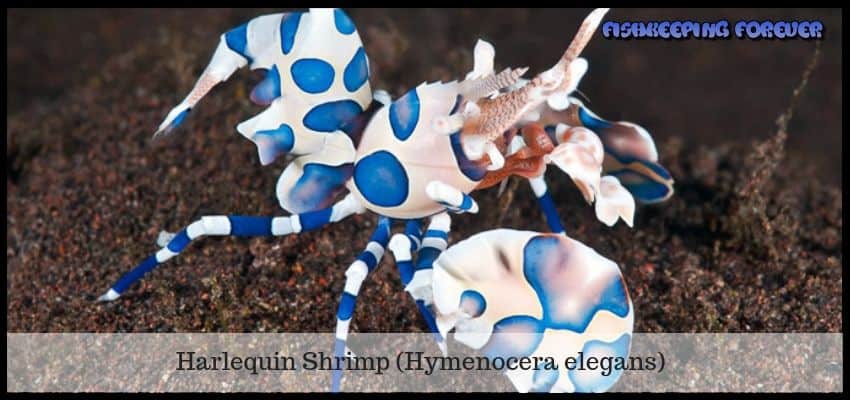
| Scientific Name | Hymenocera elegans |
|---|---|
| Family | Gnathophyllidae |
| Temperament | Peaceful |
| Care Level | Moderate |
| Origin | Africa, Indian Ocean |
| Diet | Carnivore |
| Max Size | 1.5" |
| Color | White, Blue, Tan |
| Price | $30-$40 |
This incredibly attractive 1.5-inch shrimp has a white body with large light blue spots outlined in darker blue. They are found naturally in the seas off Africa and the Indian Ocean where they are well camouflaged against a backdrop of coralline algae covered rubble.
Best kept in pairs it is usually the male that is the smaller of the two sexes. Females also have noticeable blue spots under their abdomens whilst males are either clear or yellowish.
Armed with large claws which they don’t use to hunt the Harlequin Shrimp (hymenocera elegans) is an incredibly picky eater that will only dine on starfish and a few urchin species. This makes them a species of shrimp not suited to everyone as the morality of feeding them live starfish comes into play.
Starting at the tip of the arm and working its way up to the central disc the Harlequin Shrimp will basically slowly eat a Starfish to death. This certainly makes them unsuitable for any aquarium with starfish that you want to keep alive. For aquariums, without starfish, it presents the ethical dilemma of if it is ok to use them as feeders? Harlequin Shrimp will eat around one starfish per week.
The usual care of shrimp must also be taken with Harlequin Shrimp so no copper-based medications, iodine is needed for molting and stable water conditions must be kept. Breeding is uncommon with high mortality rates for any larvae born.
#13 Marbled Shrimp (Saron marmoratus)
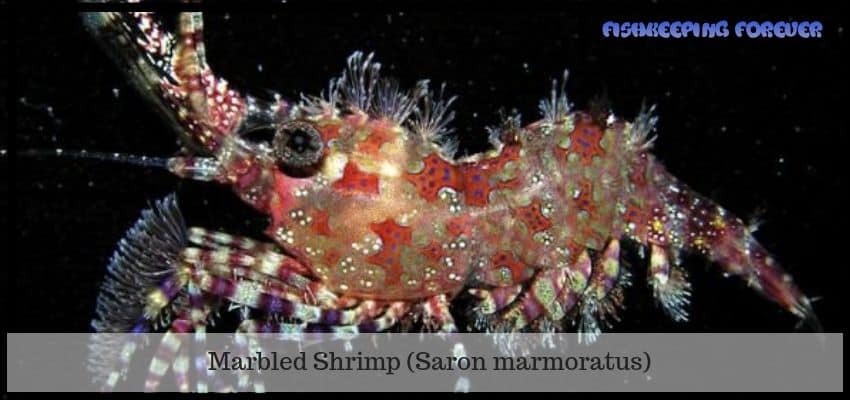
| Scientific Name | Saron marmoratus |
|---|---|
| Temperament | Peaceful |
| Family | Hippolytidae |
| Care Level | Easy |
| Origin | Hawaii, Indonesia, Maldives |
| Reef Safe | No |
| Color | Green, Red, Tan |
| Max Size | 2" |
| Price | $10 |
Also known as the carid shrimp, saron shrimp, monkey shrimp or spiked prawn the Marbled Shrimp (saron marmoratus) is a nocturnal coral and rubble dwelling shrimp from the Indo-Pacific. Not only do they perform cleaning services on fish, as many other shrimp do, but they have also been known to perform it on divers hands too.
A rather strange looking but alluring species the Marbled Shrimp is transparent to cream in coloration with reddish brown spots outlined in white. The legs are striped in brown and white and they covered in Cirri (feathery appendages) all over. Shape-wise, they are best described as hunchbacked and dumpy.
Being around 2 inches in size the Marbled Shrimp is one of the lesser predated upon shrimp but care still needs to be taken when housing them with large predatory fish. It should also be noted that males of the Marbled Shrimp species may quarrel with one another so require plenty of space when being kept together.
Marbled Shrimp are carnivores and require a diet of brine shrimp, plankton, flaked food, frozen food and small pieces of fish. They may also attack large polyped corals and chew on the mantle of tridacnid clams. This will occur at night when you will not see it, but be assured, that yes the damage done was them!
Final Thoughts: Best Saltwater Shrimps
We hope you enjoyed our article on Saltwater Shrimps for the home aquarium, we really enjoyed writing it and it brought back lots of good memories of all the amazing shrimps we have owned over the years.
I once remember owning a Pistol Shrimp that had a habit of climbing out of the tank and sitting on the glass for a few seconds then would drop back into the water. I never knew why and he/she did that and he never fell out of the tank or died. He was eventually eaten by a large wrasse that I thought was safe.! We all make mistakes, that’s part of Fishkeeping.
Let us know if you have any shrimps in your saltwater aquarium or if you are intending to introduce one to your existing tank.
If you’re looking for ideas of amazing or cool saltwater fish to add to your aquarium then you have to go read one of our posts that have been liked on our Facebook Group over 3000 times! Saltwater Fish For Beginners it has some amazing images and information for beginners and experienced fish keepers alike. Some amazing fish that you may not have thought of introducing to your aquarium. Go check it out and let us know if you liked it.
Thanks for taking the time to read our article, we hope you enjoyed it.
Happy Fishkeeping Forever!

I have been working in the tropical fish industry for over 30 years now and I’m still learning. Everyday is a school day in this hobby. In my spare time I play golf very badly!


